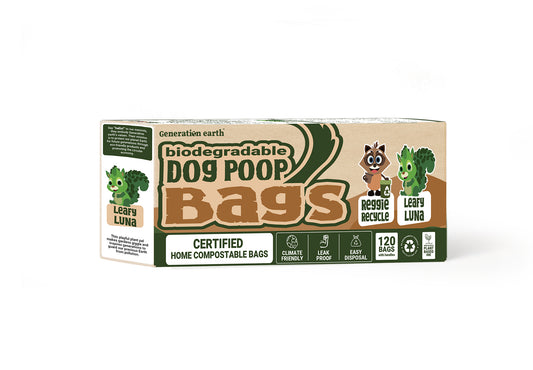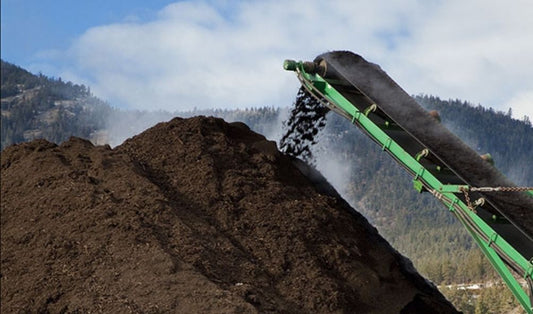
What’s the difference between compostable and biodegradable plastic?
Share
With the rising awareness of the impact plastic has on the environment, many people may wonder what the difference is between the popular compostable and biodegradable

There are several differences between compostable plastic and biodegradable plastic, namely that one still contains plastic and the other is made of natural plant starch. One is best broken down in a composter and the other will only leave behind harmful chemicals if disposed of in a composter. Compostable plastic is made to decompose back into natural compounds and biodegradable will breakdown into smaller particles but leave some toxic traces behind.
What Is Compostable Plastic And What Materials Is It Made Of?
Compostable plastic is an alternative to the typical toxic plastic most popular items such as plastic bags have been made from for decades. A ‘next-generation’ plastic, compostable plastic is made from renewable materials that will breakdown when they start to compost.

While a typical plastic bag may take thousands of years to breakdown, compostable plastic can be broken down in an industrial composter. In Australia, compostable plastic must adhere to Australian Standard 4736 and meet certain requirements such as 90 per cent biodegradation within 180 days of compost.
What is compostable plastic made from exactly? The materials vary, but include organic and renewable materials such as corn, soy protein, potato, tapioca starches, lactic acid and cellulose. These materials mean that compostable plastics are non-toxic and can decompose when composted correctly.
What Is Biodegradable Plastic And What Materials Is It Made

In addition to compostable plastic, there is another option known as biodegradable plastic. Biodegradable plastic is providing another option for consumers to feel they are protecting the environment.
The idea of biodegradable plastic is that it will breakdown faster with specially designed microbes that have the opportunity to breakdown in months rather than centuries or longer. Biodegradable plastic is also often known as ‘bio-based’ plastic as it still contains some toxic chemicals, unlike compostable plastic.
Biodegradable plastic is often made by extracting the sugar from plants like corn and sugarcane. These are then converted into polylactic acids. Another way to make biodegradable plastic is to engineer it from microorganisms which are made to break down the plastic quicker.
What Are The Fundamental Differences Between Compostable and Biodegradable Plastics?
There are many ‘bio-plastics’ emerging into the market, so what are the key differences between compostable and biodegradable plastics? There are several, from material makeup to decomposition and the environment in which they can break down.
Biodegradable plastics are manufactured to breakdown to their natural components over time. They are created through a mix of organic and chemical compounds, with added microbes engineered to attract the right microbes to decompose quickly.
Compostable plastics are made to return to the environment when they breakdown and also to provide nutrients to that environment. These are made from organic materials and able to be decomposed quickly with a home or industrial

When disposed of correctly, both can take centuries off the time it takes traditional plastic to breakdown. However, biodegradable plastics can leave behind toxic chemicals when decomposing and compostable plastics don’t.
On the other hand, if you don’t dispose of compostable plastic correctly and drop it into landfill, it will take a long time to decompose like traditional plastic. There are biodegradable plastics that, unlike compostable, are able to decompose quickly in landfill environments.
How Long Does Compostable And Biodegradable Plastic Take To Breakdown?
Traditional plastic will eventually breakdown, however, this can take centuries or even thousands of years. The aim with these plastic alternatives – such as compostable and biodegradable plastic – is that they will shorten the process to months or less.
Plastic is broken down by microbes or fungi in the environment over time. Biodegradable plastic can take three to six months to decompose completely. Some may be up to a year or more. The time frame depends on several factors such as moisture or temperature.
The environment that these plastics are placed in are key to the time it will take to break them down. For example, placed in a landfill, not all biodegradable plastics will decompose quickly. However, when composted through biowaste collection, the plastics can decompose much quicker.
This is due to the microbe-rich environment contained in an industrial composter which assists the plastic to breakdown faster. Many of these items will be marked if they are landfill-biodegradable.

Biodegradable bags unfortunately do contain some of the same materials as traditional plastic which can delay the process and cause them to degrade into toxic chemical sludge.
Compostable plastic is best broken down in an industrial composter as that’s what it is designed for rather than landfill. These composters are set up perfectly with the right temperature, moisture levels, air and other important factors for decomposition.
Compostable bags won’t decompose well in landfill and will take a long time. Typically, in the right environment, a compostable bag will take around 90 days to decompose in a compost bin.
Which Type Of Plastic Is Better For The Environment?
When it comes to deciding which plastic is the best choice for the environment, look to several factors. These include how you will dispose of the product i.e. landfill or composter; whether the product is marked as landfill-friendly; whether you can reuse the product and what other options are available to you.

If you’re choosing between biodegradable and compostable, the least toxic will be the compostable as it contains no toxic compounds. Compostable plastics will break down (when in the right environment) and not emit or leave behind any toxic material.
However, if you’re not disposing of your compostable plastic in the right environment then you should choose landfill-biodegradable so that the plastic has a chance of decomposing faster than traditional plastic. This however, can leave behind some toxic compounds after decomposition.
The makeup of these plastics also lean toward compostable as they are made up of much organic and natural materials over biodegradable which still contain more chemical compounds related to traditional plastic.
Your choices in how you dispose of the plastic really plays the key factor in which plastic is best for the environment.
Are Compostable And Biodegradable Plastics

To look at whether or not compostable and biodegradable plastics are sustainable, it’s important to look at their environmental footprint and also the longevity of sourcing the materials needed to keep making these plastics.
Compostable plastics protect the environment to an extent, being made from organic materials that are often in large supply and going back to the environment to decompose. Being able to continue making these with a smaller impact on the environment than traditional plastic is possible.
However, compostable plastics do require the right environment such as a home or industrial composter to decompose. Thus, if they’re thrown into landfill, they merely contribute to waste issues.
Biodegradable plastics rely on some chemical compounds to be manufactured, meaning they can leave behind toxic elements upon decomposition. However, the bulk of their organic material is easily sourced and easily decomposed. Some biodegradable plastics are also able to be sent to landfill.
Overall, these options are largely sustainable but the consumer’s choice on when and how to use and where to discard are key to ensuring their longevity as environmentally-friendly options.
Conclusion
When looking at which choice is best in the plastics market, it’s important to consider your usage and how you will dispose of the items. Yes, you can choose the most organic option in compostable, however, if you simply throw the item in the bin then you aren’t protecting the environment at all.
This item simply will contribute to landfill and pollution the same as traditional plastic. In this case, you are best to choose a landfill-biodegradable item which can still decompose quicker in landfill. However, if you will dispose of your compostable plastics in a composter, this is the better option.
Both types of plastic are sustainable and can protect the environment to an extent. Unfortunately, the makeup of biodegradable plastic does leave behind some toxic compounds when decomposing. Before making your choice think hard about why you need this plastics item and what you will do with it.
Consider whether or not you have access to a composter or whether you will likely dispose of the item in general waste. If you have a composter, don’t purchase biodegradable bags and expect to throw them in there. They will contaminate your green organics.
Just by reading this article, you are making a better choice to become more informed about your options and how they can benefit the environment.



